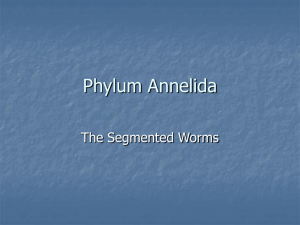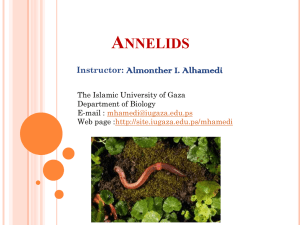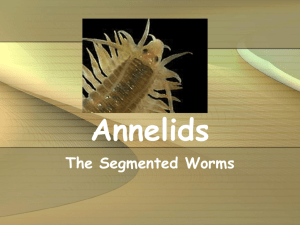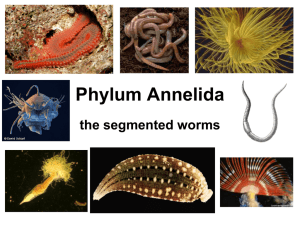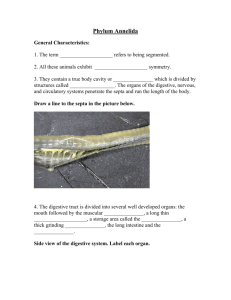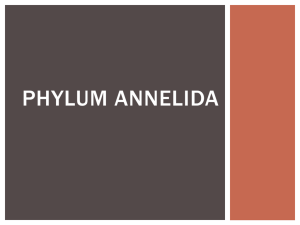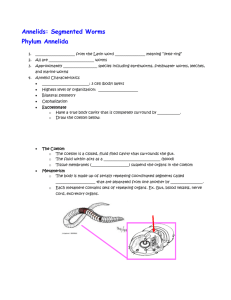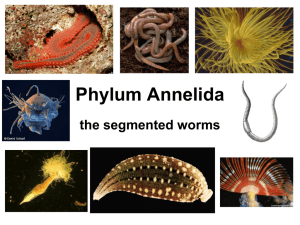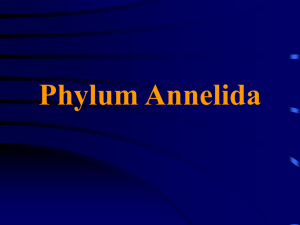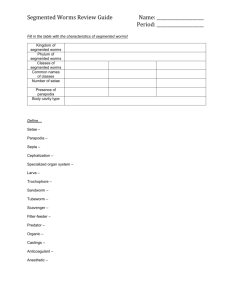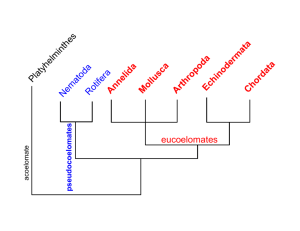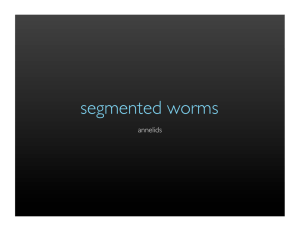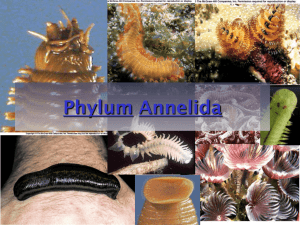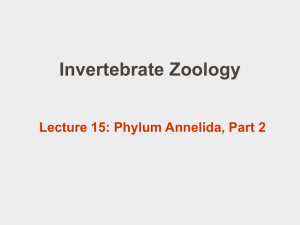Chapter 17 Annelids
advertisement
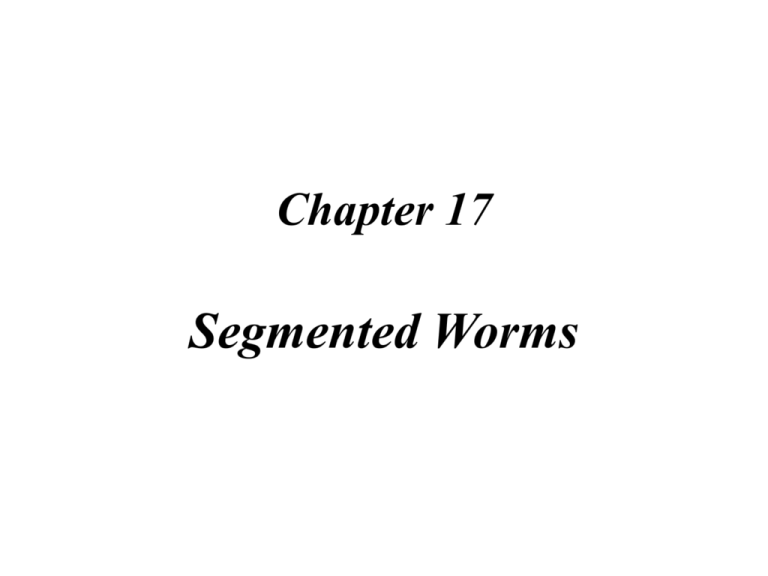
Chapter 17 Segmented Worms Outline: Things to Know! • Intro to segmented worms (P. Annelida) • Body plan • C. Polychaeta (feather-duster worms, clamworms, scaleworms, lungworms) • C. Oligochaeta (earthworms) – earthworm • form/func. • C. Hirudinea (leeches) – form/func. Evolutionary Significance of Metamerism • Origins of coelom and metamerism – coelom advantage = hydrostatic skeleton • coelomic fluid serves as circulatory fluid (food/waste) – ↓ need for wide distribution of flame cells • store gametes for timed release to ↑ fertilization – require nervous and endocrine control – metamerism ↑ burrowing efficiency • allows contraction of muscles in 1 part of body at time – independent mvmt of indiv. segments • allows ↑ control • ↑ structural/func. complexity • regeneration in some General Annelid Body Plan • Hydrostatic skeleton (fluid in coelomic cavity) • Complete digestive system • Respiratory gas exchange through skin, gills or parapodia • Excretory system-pair of nephridia for each segment (kidney like structure) Phylum Annelida • Chitinous Setae present on segments, help anchor body during locomotion to prevent body slipping (absent in leeches) • True coelom which is well developed and divided by septa (absent in leeches) • Closed circulatory system Circulatory Systemsopen vs closed 6 • Nervous system with double ventral nerve cord and a pair of ganglia with lateral nerves at each segment. “Brain” a pair of dorsal cerebral ganglia with connections to cord. • Sensory system-tactile organs, taste buds, photoreceptors, and eyes with lenses for some. • Reproduction: Hermaphroditic or separate sexes, larva if presenttrocophore type. 9 P. Annelida: C. Polychaeta • Characteristics – – – – – – feather-duster/fireworm/scaleworm/lungworms +10,000 sp. mostly marine, some fresh 1mm - 3m, colorful/dull sedentary sp. live in crevices/tubes free-moving/burrowing/crawling P. Annelida: C. Polychaeta – distinct head w/ eyes/tentacles – lateral appendages (parapodia) on most segments • have parapodia that have many blood vessels and function as gills. – w/ tufts of many setae – dioecious • asexual budding • trochophore larvae – ↑ specialization of sensory organs than clitellates – Mostly marine Class Polychaeta • Each segment of a polychaete (meaning “many setae,” for the bristles on each segment) has a pair of paddle like or ridge like structures called parapodia (almost feet) that function in locomotion. • Each parapodium has several setae made of chitin parapodia Polychaeta-Nature’s Beauty??? P. Annelida: C. Polychaeta • Circulation/respiration – – – – – most use parapodia + gills for gaseous exchange others use body surface dorsal vessel carries blood anteriorly ventral vessel carries blood posteriorly blood flows btwn dorsal/ventral vessels via segmental networks around parapodia/septa/intestine – many have respiratory pigments • Red pigment/Hemoglobin protein???? Scale worms •flattened bodies covered w/ broad scales •carnivorous some Fireworms •hollow, brittle setae w/ poison •feed on cnidarians Class Polychaeta • Many crawl, burrow into the seafloor, and many others live in tubes which the worms make using various sediment and mucus. • Use feathery tentacles to feed i.e. Christmas tree worm More Christmas Tree Worms!!!!! P. Annelida: C. Oligochaeta • Characteristics – +3000 sp. – terrestrial/freshwater • few marine/parasitic – – – – – – variable # distinct segments few setae per segment no parapodia no head hermaphroditic direct development (no larva) Copyright © The McGraw-Hill Companies, Inc. Permission required for reproduction or display. External Structures of an Earthworm 19 P. Annelida: C. Oligochaeta – earthworms • • • • • burrow in moist/rich soil emerge at night wet weather near surface dry weather burrow deep, become dormant earthworms have an important role in churning soil, mixing materials and adding nutrients – +15 tons of dry earth/acre/year passed through gut • Giant tropical earthworms –4m – live in interconnected tunnels Class Oligochaeta • Form/func. – 4 pair of chitinous setae per segment • some +100 pair – setae are bristlelike rod set in sac, move by tiny muscle – setae anchor segments during burrowing Copyright © The McGraw-Hill Companies, Inc. Permission required for reproduction or display. Internal Structures of an Earthworm 23 • Undigested material, mixed with mucus secreted into the digestive tract, is egested (eliminated) as castings through the anus. Farmers value worms and casting because they improve the texture of the soil. Darwin estimated that 1 acre of British farmland had about 50,000 earthworm that produced 18 tons of castings per year. Class Oligochaeta • Excretion of metabolic wastes occurs via nephridia – Each somite has a pair of nephridia – Wastes are dumped to a pore that discharges near the setae Metanephridium Dorsal vessel Bladder Nephridiopore Nephrostome Ventral vessel 28 Copyright © The McGraw-Hill Companies, Inc. Permission required for reproduction or display. Earthworm Reproduction 29 Class Hirudinea-The leeches • Most inhabit fresh water although some inhabit moist vegetation. • Many leeches feed on invertebrates while some are parasitic blood suckers attaching temporarily to other animals. • Some use blade like jaws to slit the skin of the host, other secrete enzymes that digest a hole through the skin. • Secrete an anesthetic • Secrete hirudin • Keeps blood from clotting • The parasite will feed until it is full (up to 10 times its own weight) then it will fall off and not feed for up to 10 months. • Leeches are used for treating bruised tissues and stimulating circulation of blood to fingers and toes that have been sewn back to hands or feet after an accident. 2 major adaptations in this phylum: 1. The coelom -provides a hydrostatic skeleton -new and diverse methods of locomotion -provides space for storage and complex organ development 2. Segmentation-allows high degree of specialization of body regions -groups of segments modified for different functions
